Caring for bird of paradise plants is easier than most people think. In this post, I’ll show you everything you need to know to keep them thriving for years to come.
In this guide I’ll teach you everything from the best location and planting, to water, fertilizer, flowers, soil, sunlight, pest control, and much more.
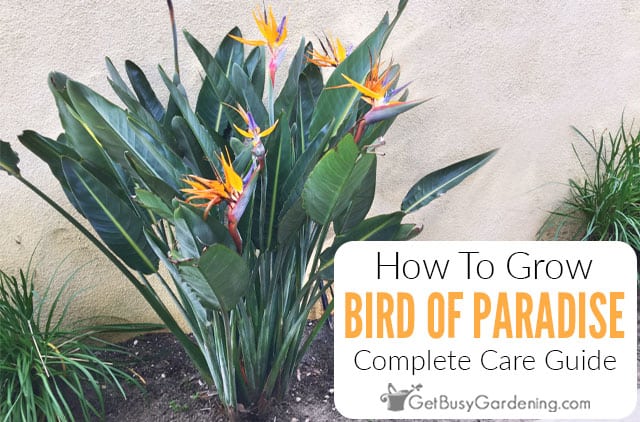
Information About Bird Of Paradise
The bird of paradise (Streilitzia, also called Crane Flower), is a native plant in South Africa, but you can grow them in any climate.
These tender perennials get their common name because of the distinctive flowers that resemble the head of a bird when they open.
The sizable, glossy foliage can reach heights of up to 6″ wide and 18″ long on smaller species, and as long as 20′ on the giants. They are very long-lived plants that can survive and bloom for decades.
Hardiness
Bird of paradise is hardy in zones 9-11, though it will need frost protection during extreme winters. Some can survive down to zone 8, but will die back to the ground in freezing temperatures.
If you live in a colder climate, you can grow yours indoors through the winter months. They make excellent houseplants.
Flowers
The long-lasting flowers of the bird of paradise plant are their most distinguishing feature. They’re beautiful, exotic, and can bloom constantly in the right environment. Hummingbirds love them too.
Sometimes it can be difficult to get them to blossom, especially indoors. In that case, follow these tips to increase the chance of flowers:
- Keep the plant snug with slightly pot-bound roots.
- Give it plenty of sunlight.
- Fertilize it monthly.
- Never allow it to dry out completely.
- Be patient.

Different Types
The most familiar type of bird of paradise are the ones with orange flowers. But, there are actually a few different varieties. Here are some of the most common ones:
- Orange bird of paradise (Strelitzia reginae) – The most well-known species with orange and blue flowers. Also called “orange bird”, this variety reaches 3-5 feet tall, and is suitable for growing in pots or indoors.
- ‘Mandela’s Gold’ bird of paradise – Also called ‘Kirstenbosch Gold’, this variety of Strelitzia reginae has yellow and blue flowers. This one is much more rare, and grows to be 4-6′ tall.
- White bird of paradise (Strelitzia nicolai) – As the biggest of the different species, the large, banana-like leaves can get up to 20 feet tall. Also called “Giant bird of paradise”, or “white bird”, this one has huge white and blue flowers that can range from 6-12″ long.
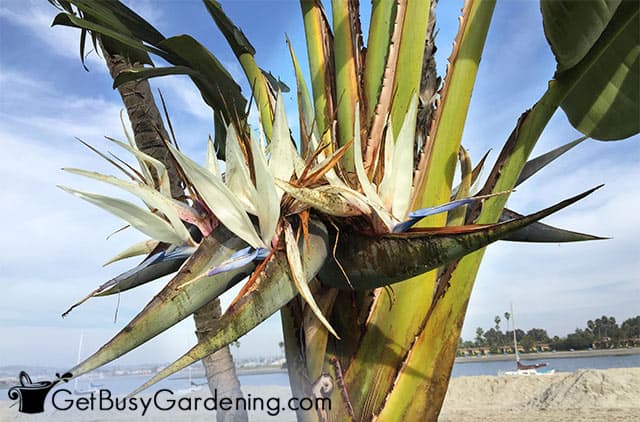
Where To Grow Bird Of Paradise
These subtropical perennials are easy to grow in the garden, as outdoor patio specimens, or indoors. They will do best in full to partial sun where they are protected from harsh winds.
In Containers
You can grow any type of bird of paradise plant in a pot, as long as the container is large enough for it.
Since the plants can get very tall, find a container with a broad, substantial base to prevent it from tipping over.
Also, be sure that it has drainage holes in the bottom. This is extremely important, and will help prevent overwatering.
Indoors
Though you can easily grow bird of paradise indoors as a houseplant year round, you may find it more difficult to get them to bloom.
Fortunately, the foliage alone is attractive, and a lovely addition to any home or sunroom. But if you want it to flower indoors, then put it outside in the summer, and bring it back inside for winter.
In The Garden Or Landscape
If you live in the right climate, then you can plant these lovely evergreen perennials in your garden or landscaping.
They require well-draining, fertile soil, high humidity, and temperatures that stay above 50°F. Choose a spot that gets regular moisture, but not where the ground becomes saturated.
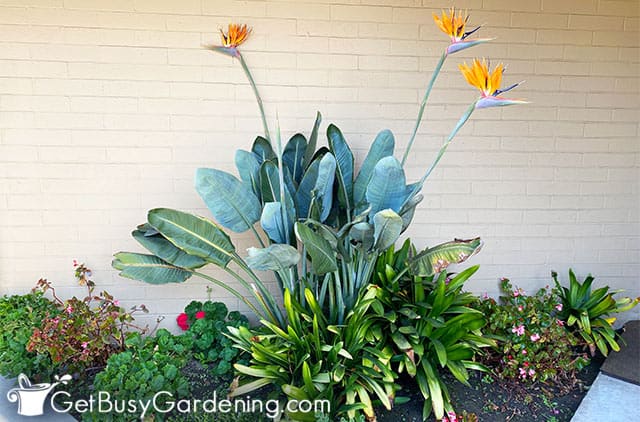
How To Grow Bird Of Paradise
Before we get into the specific bird of paradise plant care instructions, it’s important to know when and how to plant them. This will get yours off to the best start possible.
When To Plant
You can plant your bird of paradise pretty much any time of the year in temperate climates. However, avoid transplanting them on extremely hot days.
The ideal planting time is during the cooler months of the spring or fall, on a cloudy or rainy day.
Planting Tips
To plant them outside, dig a hole in the ground that is a foot or so wider, and the same depth as the pot. Don’t make the hole too deep.
Gently loosen the rootball, and place it into the hole at the same depth as it was in the pot. Take care not to plant your bird of paradise any deeper, or it may not flower well.
Fill the hole in with soil, and mulch around the base to help retain moisture. Water well for several days after transplanting.
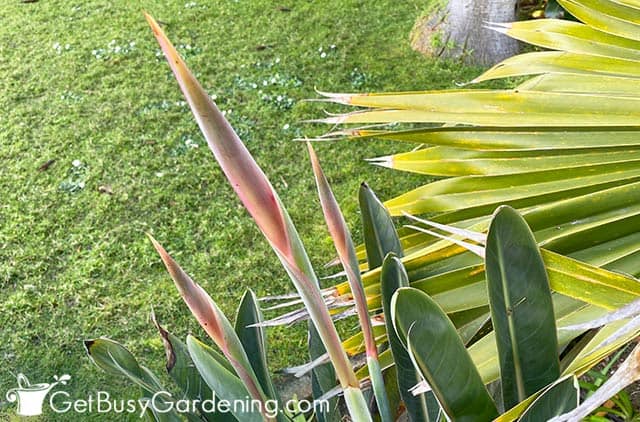
Bird Of Paradise Care & Growing Instructions
While these tough plants can survive a lot of abuse and neglect, they will bloom and grow the best with the proper conditions. Follow my detailed bird of paradise plant care instructions below.
Water
It’s essential to provide your bird of paradise with the proper amount of water. They don’t like to be overly wet, but will struggle with long periods of drought.
Try to water consistently throughout the spring and summer months to maintain evenly moist soil. But during fall and winter, allow your plant to dry out more between waterings.
If you struggle with this, I recommend getting yourself an inexpensive moisture gauge to help you out.
Also, be cautious of your water source. Do not use softened water on them, they are extremely sensitive to this type of salt. So instead, use distilled or rainwater.
Humidity
Since it is native to the subtopics, the bird of paradise plant loves humid conditions. They benefit from regular spritzing while indoors, or you can run a humidifier nearby.
Outdoors they will tolerate less humidity, but extremely dry air can cause the leaves to split, turn brown, and/or curl at the ends.
Fertilizing
They are heavy feeders, so fertilizing them regularly is very important for blooming, especially if you have your plant in a container.
For best results, add slow-release granules to the hole at planting time, then top-dress them monthly through the spring and summer.
You can also use a liquid plant food on them each time you water. Use one for blooming plants, an organic compost tea, or liquid fish emulsion.
Stop feeding them in the fall, and don’t fertilize at all in the winter during their dormant period. Learn more about fertilizing flowers here.
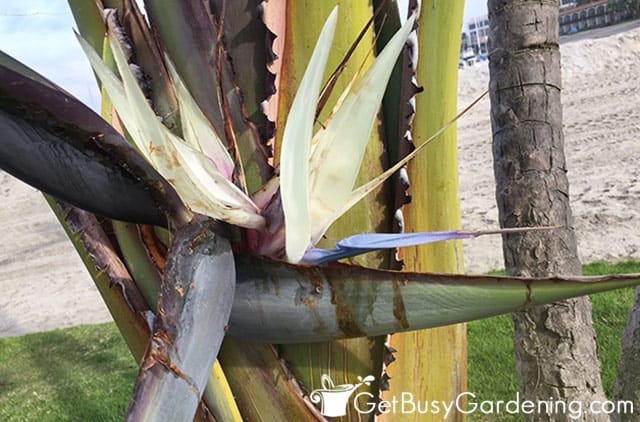
Soil
When it comes to the soil, bird of paradise plants aren’t too fussy. But they will do best in soft, workable soil that is high in organic matter.
It should be well-draining, but also retain moisture. You can amend poor garden soil with compost or worm castings to add nutrients and moisture retention. Otherwise, use a high-quality mix for containers.
Repotting
Bird of paradise plants can live in the same pot for many, many years. They love to be pot-bound, and repotting them too often may inhibit blooming.
Only repot yours if the roots have completely outgrown the container, the plant’s health is declining, or the pot has become so top-heavy that it keeps falling over.
Also, choose a pot that is only slightly larger than the last. And keep in mind that it may take a year or so for them to flower again after being repotted.
Sunlight
Bird of paradise plants need 6 or more hours of full sun per day. If they get too much shade, they won’t flower as well.
However, you should protect them from the intense afternoon sun if you live in an extremely hot and dryer climate, or it can burn the leaves. In this case, give them partial sun in the morning and/or evening.
Indoors place your plant in a sunny south-facing window, or add a grow light if it starts reaching for light. You can’t give it too much light inside the house.

Pest Control
With the proper care, healthy bird of paradise plants have very few pest problems. But yours may become infested by mealybugs, scale, or spider mites.
To prevent an outbreak, or treat a minor one, periodically wipe the leaves with a rag soaked with diluted soapy water (always use a mild liquid soap).
For heavier infestations, you can use neem oil, or wash the leaves with insecticidal soap. Test any new sprays on a few leaves to make sure they don’t cause any damage before treating the entire plant.
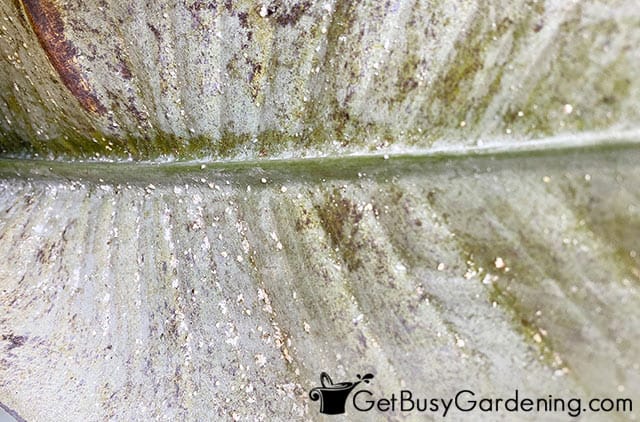
Pruning
Regular pruning is another important part of caring for your bird of paradise plant, and to keep it growing and looking its best. It also helps to encourage vigorous new foliage, and tons of flowers.
Trim out any unhealthy or dying foliage as necessary, and cut the flowers down to the base after they fade.
Bird Of Paradise Propagation Tips
There are two ways to propagate your bird of paradise, either by division or growing the seeds. To divide it, you can either split up the rootball, or remove the side shoots and pot them up.
Otherwise, if the flowers are pollinated, seeds will form. Collect them and remove the fleshy coating before direct sowing or storing them.
Troubleshooting Common Problems
The hardest part about bird of paradise plant care is when something goes wrong, and you have no idea how to fix it. So, in this section, I’ll help you troubleshoot some of the most common problems you may have with yours.
Broken Stalk
It’s not uncommon for the tall stems to snap in a storm or heavy winds. Simply prune the broken stalks down to the base as necessary. If this is a recurring issue, you might want to move your plant to a more protected location.
Leaves Splitting
Lack of humidity and water, or strong winds, especially for taller varieties, are also all common causes of splitting leaves.
Move the plant to a spot where it will be protected from the wind, trim off the heavily tattered leaves, and ensure it is getting plenty of water.
Leaves Curling
Most often caused by lack of water, the leaves can also curl in low humidity, or if there’s some kind of pest infestation.
Make sure you’re watering consistently – the soil should never dry out completely. Check the curled leaves for bugs, and treat any that you find right away.
Not Flowering
On established plants, lack of flowers could be caused by improper watering, nutrient deficiencies, or too much shade.
However, it can take a few years for a new bird of paradise plant to bloom, even with the perfect care. So you may just need to give it more time.
Leaves Turning Brown
When the leaves turn brown, it could be from sunburn, not enough humidity, lack of water, or insects.
Inspect your plant for bugs, move it to a shadier spot if it’s getting sunburn, and ensure you’re giving it the proper amount of water.
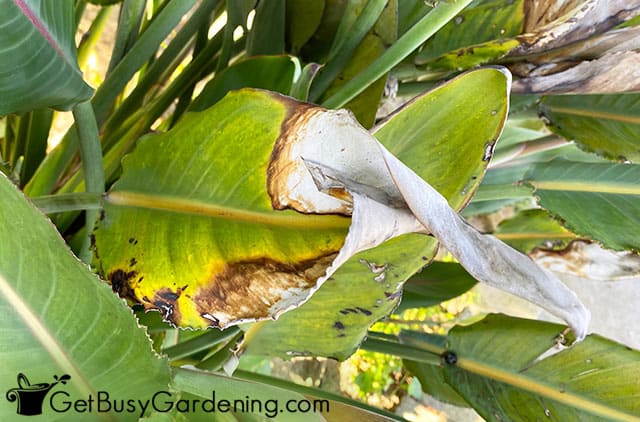
Bird Of Paradise Care FAQs
Below I will answer some of the most frequently asked questions about bird of paradise plant care. If you can’t find your answer here, then ask it in the comments below, and I’ll be happy to answer it ASAP.
How do I get my bird of paradise to bloom?
Fertilizer and sunlight are the two main things bird of paradise plants need to bloom. Containerized plants like to be root-bound, and may not flower if the pot is too large.
How long does it take for a bird of paradise to grow?
Bird of paradise is a fast-growing plant, but it can take 3-5 years for a seedling or small specimen to grow to the full, mature size.
How much sunlight does a bird of paradise need?
It depends on where you live. In temperate climates, bird of paradise plants do best in full sun. In hot, dry regions, they grow best in partial shade where they are protected from the intense afternoon sun.
How often should you water a bird of paradise plant?
Rather than automatically watering on a set schedule, always be sure to check the soil first to make sure it’s not already wet. But in general, water bird of paradise plants weekly during the summer months. In the fall and winter, allow the soil to dry slightly between waterings.
With the proper care, you can enjoy the gorgeous and unusual bird of paradise plant for many years to come.
More About Flower Gardening
- How To Grow Canna Lilies: Complete Care Guide
- How To Care For Angel’s Trumpet (Brugmansia)
- Bougainvillea Care & Growing Guide
- How To Grow Zinnias: The Ultimate Guide
- How To Grow Hydrangeas: Complete Care Guide
- How To Care For A Voodoo Lily Plant
- How To Care For Poinsettias Outside
Share your bird of paradise plant care tips in the comments section below.
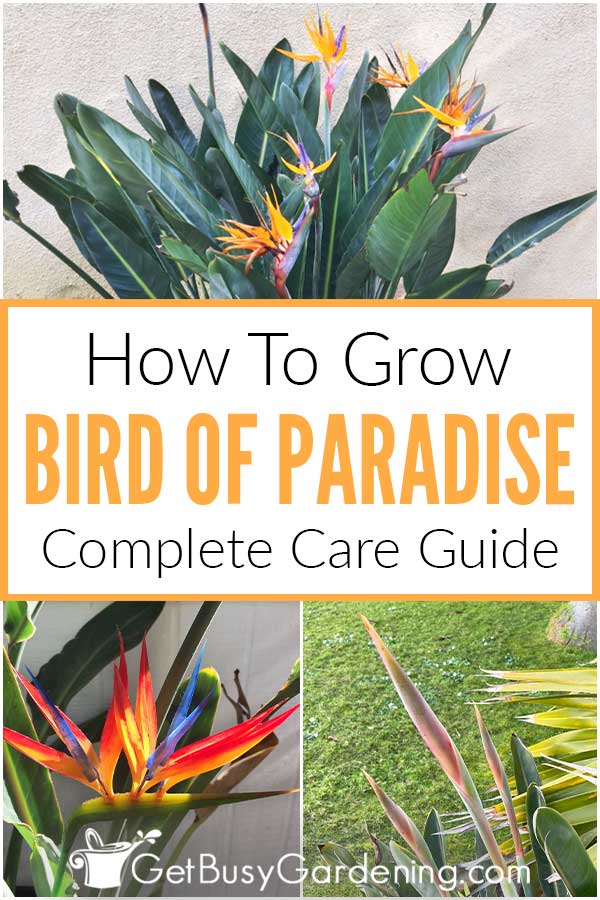
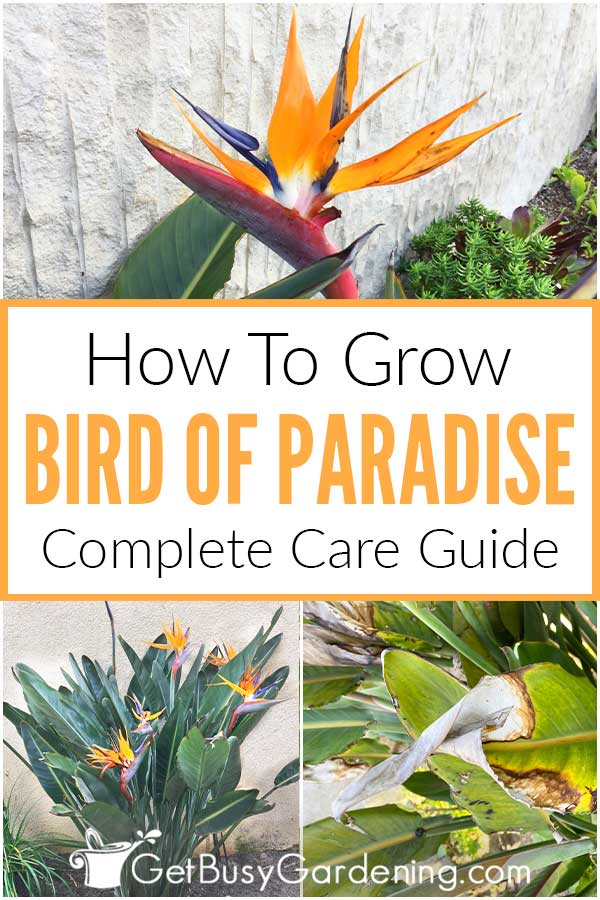
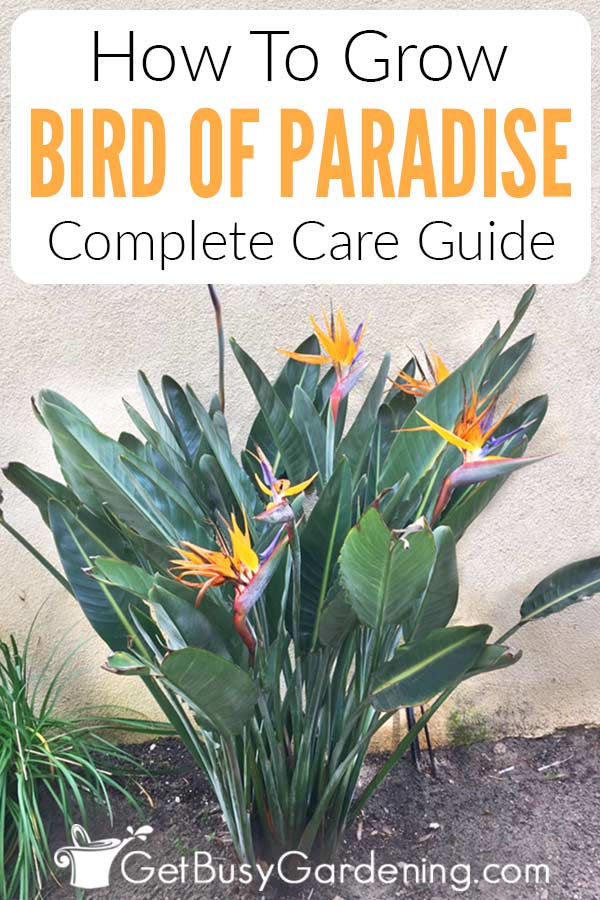


Lucie says
Hi, if I want to plant more of these in my garden, how far apart should I space them? Thank you
Amy Andrychowicz says
The plant tags should tell you for sure, as it depends on the size of the bird of paradise variety you have. But in general, it’s usually best to space them 4-6 feet apart.
Michelle says
I just received my first plant. I live west coats of Florida my concern is my townhouse faces east and west, so I get very hot in the mornings then hotter in the evening. Unable to bring it inside and no patio. Help!
Amy Andrychowicz says
In that case, I recommend planting your bird of paradise on the east side of your house, where it will get morning sun rather than the more intense afternoon rays. They can take the heat, but do best when protected from the sun in the afternoon. Also, make sure it get regular waterings in the summer, and it’s well irrigated during the hottest days.
Hyun says
Hi, my bird of Paradise stems died but roots are still firm and intact with no rot. I had to trim it close to the root because leaves were rotting from where broken stem was. Is there a way to save the plant with just the root? Thank you!
Amy Andrychowicz says
It sounds like your bird of paradise may have been getting too much water, and that’s why the leaves rotted and died back. As long as the roots are still healthy and the watering problem is corrected, it should come back. They are drought tolerant, and don’t like soggy soil. So, make sure to allow it to dry at least 2″ deep between waterings. If it’s in a pot, ensure there are adequate drainage holes so the excess water runs out the bottom and never pools in there.
Ryan says
Bought potted birds at Lowes house n SW FL.
Over the years they have thinned snd forest into the surrounding grass. How can I keep them thick and in one confined area.
Amy Andrychowicz says
The best way to keep bird of paradise thick and full is to divide them every few years. At that time, you can also dig up the runners, and remove them. Really the only way you can keep it fully contained is to either plant it in a pot, or somewhere like a raised bed, retaining wall, or on a boulevard where they don’t have any place to spread.
Angela says
I have a very large bird of paradise that outgrew its pot and fell over. I’ve already started to cut it out of its pot. Can I cut the roots On the bottom and plant it the ground? Or should I try to separate each one and put them in a new pot?
Amy Andrychowicz says
It depends on where you live. If you’re in a warm enough climate (zone 9b or higher), you can plant your bird of paradise in the ground. Otherwise, unless you want to dig it up in the fall to overwinter it indoors, it would be much easier to divide it into smaller pots.
Nicole says
Hi, this is so fabulous! I recently got 8 long bird of paradise flower stems ( my absolute favorite flower) I want to maintain them/ root/plant them. Is this possible? If not what’s the best way to maintain them for as long as possible? By the way, it’s November in Detroit, MI. First snow yesterday. Thanks so much!
Amy Andrychowicz says
Unfortunately cut bird of paradise flower stems won’t root. To keep them fresh as long as possible, make sure the water stays clean and clip the bottoms of the stems every few days. Enjoy!
Kathleen says
Hi Amy,
I’m next door in SD, 5a. Can both orange and white bird of paradise be grown in the same pot together?
Kathleen
Amy Andrychowicz says
I would definitely recommend that you keep your two bird of paradise plants in separate pots. They will grow into quite large specimens (especially the white one), so they’ll need lots of room. Enjoy!